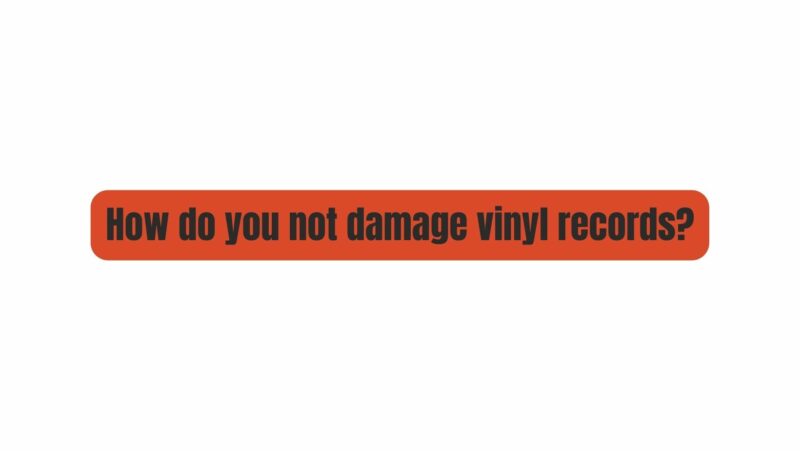In an age dominated by digital music streaming, vinyl records have made a remarkable comeback. Vinyl’s analog warmth and tactile charm continue to captivate audiophiles and music enthusiasts worldwide. However, vinyl records are delicate and can be susceptible to damage if not handled and cared for properly. In this comprehensive guide, we will explore essential tips and strategies to help you preserve and protect your vinyl records, ensuring they provide years of listening pleasure.
The Fragility of Vinyl Records
Vinyl records are a marvel of analog technology, but their fragility is inherent to their design. Unlike digital formats, vinyl records are susceptible to physical damage, which can result in audible imperfections, such as pops, clicks, and skips. Therefore, it’s essential to understand the potential sources of damage and how to mitigate them.
Common Causes of Vinyl Record Damage
- Dust and Dirt: Dust particles and debris can settle into the grooves of a record, causing audible surface noise and distortion.
- Scratches and Scuffs: Physical contact with sharp objects, rough handling, or mishandling can lead to scratches and scuffs on the surface of the vinyl, affecting sound quality.
- Warping: Exposure to heat or uneven pressure during storage can cause vinyl records to warp, making them unplayable.
- Static Electricity: Static electricity can attract dust and debris to the record’s surface, resulting in increased surface noise.
- Mold and Mildew: Improper storage in a humid environment can promote the growth of mold and mildew on the record’s surface, leading to permanent damage.
Now, let’s delve into strategies and best practices to protect your vinyl records from these common sources of damage.
1. Handling and Cleaning
Proper handling and cleaning are fundamental to preserving the condition of your vinyl records.
- Handle with Care: Always hold records by the edges and avoid touching the playing surface with your fingers to prevent the transfer of oils and dirt. Invest in a record clamp or center label spindle adapter to facilitate safe handling.
- Use a Carbon Fiber Brush: Before each play, use a carbon fiber brush to remove surface dust and debris. Gently sweep the brush in the direction of the grooves.
- Cleaning Solution: For more thorough cleaning, use a vinyl record cleaning solution and a soft, anti-static brush. Apply the solution to the brush and gently clean the record’s surface in a circular motion.
- Avoid Household Cleaners: Never use household cleaners, solvents, or abrasive materials to clean vinyl records, as they can cause irreversible damage.
2. Proper Storage
How you store your vinyl records has a significant impact on their longevity and condition.
- Store Vertically: Always store records vertically, like books on a shelf. Storing them horizontally can lead to warping over time.
- Use Polythene Sleeves: Invest in high-quality polythene or polypropylene inner sleeves to protect the vinyl from dust and static. Avoid paper sleeves, as they can create scratches.
- Outer Sleeves: Place records in clear, polythene outer sleeves to protect them from dust, moisture, and handling damage.
- Climate-Controlled Environment: Store your records in a stable, climate-controlled environment with a temperature range between 65°F (18°C) and 70°F (21°C) and a humidity level between 40% and 60%.
- Avoid Sunlight: Keep records away from direct sunlight, as prolonged exposure can cause warping and damage to album covers.
3. Preventative Measures
Preventative measures can help protect your vinyl records from common sources of damage.
- Use a Record Mat: Place a record mat under your turntable to reduce vibrations and prevent scratches caused by dust or debris on the turntable platter.
- Anti-Static Brush: Invest in an anti-static brush for your turntable’s stylus to prevent static buildup on the record’s surface.
- Storage Furniture: Consider dedicated vinyl storage furniture or crates designed to accommodate your collection safely.
4. Avoid Mishandling
Proper handling practices can prevent accidental damage to your vinyl records.
- Set the Tonearm Correctly: Ensure that the turntable’s tonearm is set to the correct tracking force and anti-skating settings to avoid excessive pressure on the record’s grooves.
- Use a Dust Cover: If your turntable has a dust cover, keep it closed when not in use to prevent dust from settling on the record.
- Gentle Cueing: When cueing a record, gently lift the tonearm and place it on the desired track. Avoid dropping the needle abruptly onto the vinyl.
5. Inspection and Maintenance
Regular inspection and maintenance can help identify and address potential issues before they worsen.
- Visual Inspection: Examine your vinyl records under good lighting to spot any visible scratches, scuffs, or signs of wear.
- Check Your Equipment: Periodically inspect your turntable, stylus, and cartridge for any signs of wear or damage. Replace worn or damaged components promptly.
- Replace Sleeves: If inner or outer sleeves become worn or damaged, replace them to continue protecting your records.
6. Be Mindful of Outer Covers
The outer covers or jackets of vinyl records are also susceptible to damage. To protect them:
- Use Outer Sleeves: Store records in clear, polythene outer sleeves to shield the cover from dust and moisture. This helps preserve the cover’s condition and value.
- Handle Covers with Care: When removing records from their covers, be gentle to avoid cover wear or seam splits.
7. Digitize Your Collection
Consider digitizing your vinyl record collection to reduce wear and tear from frequent playback. This allows you to enjoy your music digitally while preserving the vinyl for special listening occasions.
Conclusion
Vinyl records are not only cherished for their sonic quality but also for the tactile experience they provide. Preserving your vinyl collection involves diligent care and attention to detail. By implementing the strategies and best practices outlined in this guide, you can safeguard your vinyl records from common sources of damage, ensuring that they continue to deliver exceptional sound quality and provide listening pleasure for years to come. Remember that proper care and maintenance are essential for preserving the magic of vinyl records in the digital age.


